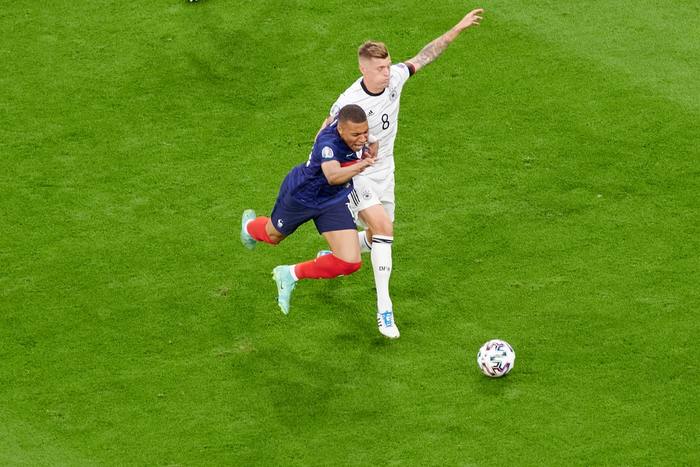The fastest soccer player in the world is currently Kylian Mbappé. Known for his electrifying speed, Mbappé has consistently clocked impressive sprint times on the field, making him a force to be reckoned with.
As a forward for both Paris Saint-Germain and the French national team, Mbappé’s acceleration and agility allow him to leave defenders in his wake and create scoring opportunities for himself and his teammates. His ability to reach top speeds in a matter of seconds has earned him the title of the fastest soccer player in the world.
With his exceptional pace and natural talent, Mbappé has become a key player in today’s soccer landscape, leaving fans and rivals in awe of his rapid movements on the pitch.
Importance Of Speed In Professional Soccer
Speed is crucial in professional soccer, and the title of the fastest player in the world is highly sought after. The ability to reach incredible speeds on the field gives players a significant advantage, allowing them to outrun defenders and create scoring opportunities for their team.
The fastest soccer player in the world possesses a unique combination of athleticism, technique, and agility that sets them apart from the rest.
Speed As A Game-changing Attribute In Soccer
When it comes to professional soccer, speed plays an essential role in determining the outcome of a game. The ability of players to outpace their opponents can lead to game-changing moments and decisive victories. Speed has become a sought-after attribute in modern soccer, with teams consistently looking for players who possess lightning-fast pace. In this section, we will explore the importance of speed in professional soccer and how it affects different aspects of the game.
How Speed Affects Different Aspects Of The Game
1. Offensive Breakthroughs: Speed has the power to break through defensive lines, leaving opponents trailing in their wake. A rapid burst of acceleration can create newfound attacking opportunities and catch defenders off guard. Quick and agile forwards, who possess exceptional speed, can exploit gaps in the opposing defense, creating scoring chances that otherwise would not have existed. Their ability to outrun defenders not only puts pressure on the opposition but also acts as a catalyst to break defensive lines.
2. Counter-Attacks: In transition from defense to attack, speed becomes an invaluable asset. Possessing players with rapid pace allows teams to swiftly counter-attack, catching opponents off-balance and reducing their chances for recovery. Counter-attacks require quick and incisive moves, and speed becomes crucial in exploiting gaps in the opposition’s defense.
| Speed Aspects | Impact on the Game |
|---|---|
| 3. Dribbling: | Dribbling at high speeds is a challenging task, but when executed effectively, it can create havoc in the opposition’s defensive setup. Players with great speed and ball control can bypass multiple defenders, creating opportunities for themselves or their teammates. |
| 4. In-Game Transitions: | Speed is critical during quick in-game transitions, allowing players to change defense into attack and vice versa rapidly. This enables teams to maintain momentum and control, while catching their opponents off-guard. |
| 5. Defending: | Speed is not only crucial for the attackers; defenders with rapid pace can close down opponents, preventing them from breaking through the defensive line. Quick defenders can frustrate opposition attacks, make crucial interceptions, and ensure their team’s solidity. |
- 6. Set-Piece Situations: Speed becomes crucial during set-piece situations, especially while executing a fast break after winning possession. Quick players can rapidly move the ball forward, catching the opposition off-guard and creating scoring opportunities from seemingly dead situations.
In conclusion, speed is an attribute that can turn the tide in professional soccer. Whether it is breaking through defensive lines, initiating counter-attacks, or simply maintaining control during transitions, speed holds the power to make or break a game. Teams now understand the significance of speed and actively seek players who can bolster their attacking prowess with rapid pace. As the sport continues to evolve, the role of speed in soccer will only become more significant.
Key Metrics In Measuring Speed
When it comes to determining who is the fastest soccer player in the world, there are several key metrics that are used to measure speed. These metrics give us a clear understanding of the explosive power, maximum velocity, and quick reactions that set the fastest players apart from the rest. In this article, we will delve into three important metrics that are commonly used to evaluate the speed of soccer players: acceleration, maximum speed, and reaction time.
Acceleration
Acceleration is a crucial metric in measuring speed on the soccer field. It refers to the ability of a player to rapidly increase their speed from a stationary position or during a short burst of movement. A player with exceptional acceleration can quickly leave their opponents behind and gain an advantageous position on the field.
When evaluating acceleration, certain factors come into play:
- Power: A player’s power plays a significant role in their acceleration. The more power a player can generate through their leg muscles, the quicker they can propel themselves forward.
- Technique: Proper technique is crucial for maximizing acceleration. This includes elements such as the angle of the player’s body, the mechanics of their stride, and how efficiently they use their arms for balance and propulsion.
- Explosiveness: The explosive strength of a player is another crucial factor in acceleration. Explosiveness refers to the ability to rapidly generate force and transfer it into rapid movement. Players with strong explosive capabilities can quickly accelerate past their opponents.
Maximum Speed
While acceleration focuses on how quickly a player can reach their top speed, maximum speed measures the highest velocity a player can attain during a sprint. Having an impressive maximum speed allows players to swiftly cover long distances on the field, chase down opponents, or execute quick counter-attacks.
Several factors contribute to a player’s maximum speed:
- Stride Length: The length of a player’s stride can directly affect their maximum speed. Longer strides cover more ground in each step, enabling players to cover more distance with fewer steps.
- Biomechanics: The biomechanics of a player’s running form greatly impact their maximum speed. Proper alignment of the body, efficient leg extension, and arm movement all contribute to maximizing speed.
- Strength and Endurance: A player’s overall strength and endurance play a crucial role in sustaining and maintaining their maximum speed over an extended period. Strong muscles and good physical conditioning are essential for sustaining high velocity throughout a match.
Reaction Time
In the fast-paced world of soccer, quick reactions can be the difference between seizing an opportunity or missing out. Reaction time measures how quickly a player can respond to a stimulus or change in the game, often in the form of a pass or a defensive maneuver by an opponent.
- Visual Perception: The ability to quickly identify and process visual cues is key to reacting swiftly. Players with excellent visual perception can anticipate and react to situations faster than their counterparts.
- Decision Making: Quickly assessing a situation and making the right decision is crucial in soccer. Players with sharp decision-making skills can react faster and make smarter choices when presented with different scenarios on the field.
- Mental Agility: Mental agility refers to the speed at which a player’s mind processes information and translates it into action. Players who possess mental agility can react faster and adapt to changing circumstances more effectively.
These key metrics, acceleration, maximum speed, and reaction time, play a vital role in determining the fastest soccer player in the world. While each individual metric holds its own significance, it is the combination of these factors that enhances a player’s overall speed and sets them apart as the fastest on the field.
Analyzing The Fastest Soccer Players
When it comes to soccer, speed can be a game-changer. The ability to sprint past opponents or chase down loose balls can create scoring opportunities and turn the tide of a match. In this article, we will analyze three of the fastest soccer players in the world: Cristiano Ronaldo, Kylian Mbappé, and Sadio Mané.
Cristiano Ronaldo: A Speed Demon
Cristiano Ronaldo is not only known for his incredible skill and goal-scoring prowess, but also for his lightning-fast speed. With an impressive top speed of 33.6 kilometers per hour (20.9 miles per hour), Ronaldo can leave defenders in the dust. His powerful strides and impeccable acceleration make him a force to be reckoned with on the field.
But it’s not just his straight-line speed that sets Ronaldo apart. He possesses exceptional agility and quickness, allowing him to change direction with ease and confuse his opponents. Whether he’s dribbling past defenders or making explosive runs behind the defense, Ronaldo’s speed is a key weapon in his arsenal.
Kylian Mbappé: Lightning-quick Dash
Kylian Mbappé is another player who has earned a reputation for his electrifying speed. With a top speed of 36 kilometers per hour (22.4 miles per hour), Mbappé is one of the fastest players in the history of soccer. His acceleration is truly remarkable, as he can go from zero to full speed in just a few short strides.
What sets Mbappé apart is not just his raw speed, but also his ability to maintain his pace over longer distances. Whether he’s making blistering runs down the wing or tearing through the middle of the pitch, Mbappé’s speed is a weapon that constantly keeps defenders on their toes.
Sadio Mané: Blistering Pace
Sadio Mané is widely regarded as one of the fastest players in the Premier League. His remarkable speed, combined with his agility and ball control, makes him a nightmare for opposing defenders. With a top speed of 34.8 kilometers per hour (21.6 miles per hour), Mané is a constant threat on the pitch.
What sets Mané apart is not just his ability to sprint past opponents, but also his clever positioning and intelligent runs. He knows exactly when to make his move and exploit any gaps in the defense. Mané’s blistering pace has played a crucial role in the success of his team, both in domestic competitions and on the international stage.
In conclusion, Cristiano Ronaldo, Kylian Mbappé, and Sadio Mané are all incredibly fast soccer players who can leave defenders in their wake. Their speed, combined with their technical skills and tactical awareness, make them a nightmare for opposing teams to handle. Whether it’s Ronaldo’s explosive power, Mbappé’s lightning-quick dash, or Mané’s blistering pace, these players are truly a joy to watch for any soccer fan.
Determining The Fastest Soccer Player In The World
Speed is a key element in soccer. The ability to sprint past defenders and outrun opponents is often what sets apart the best players. But who exactly holds the title of the fastest soccer player in the world? In this article, we will explore the contenders for this prestigious title and discuss how it can be determined.
Usain Bolt’s Foray Into Soccer
One name that immediately comes to mind when discussing speed is Usain Bolt. The Jamaican sprinter is widely recognized as the fastest man in the world, with numerous Olympic gold medals and world records under his belt. While Bolt is primarily known for his achievements on the athletics track, he briefly ventured into the world of soccer in 2018.
Bolt joined the Australian club Central Coast Mariners, where he showcased his speed and athleticism as a forward. Although he didn’t make a professional breakthrough in soccer, his participation shed light on the potential influence of pure speed in the game.
Other Contenders For The Title
While Usain Bolt’s speed is undeniably impressive, there are other soccer players who are strong contenders for the title of the fastest in the world. Let’s take a look at some of them:
- Kylian Mbappé: The French forward is renowned for his incredible pace and acceleration. Mbappé’s speed on the field has helped him become one of the most feared attackers in the world.
- Gareth Bale: The Welsh winger is known for his blistering speed, often leaving defenders in his wake. Bale’s quickness has been a valuable asset for both club and country.
- Sadio Mané: The Senegalese forward possesses lightning-fast speed combined with excellent dribbling skills. Mané’s rapid pace has made him a crucial player for Liverpool and a constant threat to opposing defenses.
- Leroy Sané: The German winger is known for his explosive speed and agility. Sané’s ability to sprint down the flank and leave defenders behind has made him a coveted player in the soccer world.
- Héctor Bellerín: The Spanish right-back is recognized for his remarkable speed, often utilizing it to recover defensively and launch swift counter-attacks. Bellerín’s rapid pace has earned him a reputation as one of the quickest defenders in the sport.
While these players are among the top contenders, determining the fastest soccer player in the world is no easy task. It often requires comprehensive analysis of various factors such as sprinting speed, acceleration, agility, and reaction time, among others.
Additionally, it’s important to note that speed alone does not guarantee success in soccer. Technical skills, decision-making, and game intelligence are also crucial in order to fully exploit the advantages gained from extraordinary speed.
Ultimately, the title of the fastest soccer player in the world is subjective and can vary depending on the criteria used for evaluation. However, the speed and skill exhibited by players like Usain Bolt, Kylian Mbappé, Gareth Bale, Sadio Mané, Leroy Sané, and Héctor Bellerín certainly make them worthy contenders for this prestigious title.
Influence Of Speed On Team Tactics And Strategy
When it comes to the game of soccer, speed plays a pivotal role in shaping team tactics and strategy. The influence of speed on a team’s gameplay cannot be overstated, as it has a profound impact on both offensive and defensive aspects of the game. In this blog post, we will explore how speed affects team tactics and strategy, with a focus on counterattacks and fast breaks, defensive capabilities, and attacking prowess.
Counterattacks And Fast Breaks
One of the most critical aspects of a team’s strategy is the ability to transition quickly from defense to offense. Counterattacks and fast breaks are the perfect opportunities for a team to capitalize on their speed and catch their opponents off guard. By swiftly launching forward with quick passes and explosive runs, teams can create scoring opportunities that can catch even the most organized defenses by surprise.
To illustrate the importance of speed in counterattacks, let’s take the example of a winger known for his lightning-fast pace. As soon as his team recovers the ball, he can unleash his blistering speed to sprint down the wing, leaving defenders struggling to keep up. This quick transition from defense to offense not only puts pressure on the opposing team but also allows the winger’s teammates to position themselves strategically, ready to receive the ball and launch a fast and lethal counterattack that can change the course of the game.
Defensive Capabilities
In addition to its impact on offensive tactics, speed also significantly influences a team’s defensive capabilities. A fast defender can act as a crucial asset when it comes to nullifying the threat posed by fast attacking players from the opposing team. Their ability to swiftly close down space and track the movements of their opponents can disrupt the flow of the opposing team’s attack. Furthermore, their speed and agility enable them to recover quickly from rare defensive errors and regain control of the situation.
A fast defender can break up the opposition’s play and intercept passes, preventing dangerous attacks from developing. Their speed allows them to close down gaps, deny attackers space to maneuver, and challenge opponents effectively. This defensive speed can be the difference between conceding a goal or making a vital clearance in the blink of an eye.
Attacking Prowess
Speed is also instrumental in enhancing a team’s attacking prowess. A quick forward can cause havoc in the opponent’s defense by constantly stretching their backline and exploiting any gaps that may emerge. Their rapid acceleration can create space, disorganize the defense, and create scoring opportunities for themselves and their teammates.
When combined with technical skills and positional awareness, speed becomes an extraordinary weapon for attackers. By threatening the defensive line with their pace, they force defenders to retreat, creating room for midfielders and supporting attackers to exploit. The ability to outpace defenders not only opens up goal-scoring opportunities but also forces the opposing team to adjust their strategy, allowing other players to find themselves in advantageous positions to exploit.

Credit: m.youtube.com
Frequently Asked Questions On Who Is The Fastest Soccer Player In The World
Who Is Considered The Fastest Soccer Player In The World?
The title of the fastest soccer player in the world is contested, but many consider Kylian Mbappe as one of the fastest. Known for his explosive speed and quick bursts of acceleration on the field, Mbappe has proven himself as a top contender in this category.
How Does A Soccer Player’s Speed Affect Their Performance?
A soccer player’s speed can greatly impact their performance on the field. The ability to outrun opponents allows players to create scoring opportunities, make crucial interceptions, and recover quickly in defense. Speed can give players an edge in one-on-one situations and increase their overall effectiveness in the game.
What Factors Contribute To A Soccer Player’s Speed?
Several factors contribute to a soccer player’s speed. Genetics play a role, as some individuals naturally have a higher level of fast-twitch muscle fibers. Training and conditioning also play a significant role, including exercises that focus on sprinting, agility, and quickness.
Additionally, a player’s technique, body composition, and overall fitness level can contribute to their speed.
Conclusion
In the fast-paced world of soccer, the title of the fastest player carries immense prestige. With electrifying speed and undeniable talent, the search for the fastest soccer player in the world becomes a quest to witness sheer brilliance on the field.
With players like Kylian Mbappé, Leroy Sané, and Adama Traoré making waves, it is difficult to crown just one. However, what matters most is the pure excitement and joy they bring to the beautiful game. So, whether it’s lightning-fast sprints or lightning-fast footwork, these superstars continue to captivate audiences worldwide and inspire the next generation of speedsters to make their mark on the pitch.

General Manager & Auditorial Head.
Killian Jake is a World Sports Traveler and hobbyist sports lover. By exploring different sorts of playing modules like indoor, outdoor, and many more. As for professionalism and writing, it’s helpful to give you the right suggestions on different games and sports.





